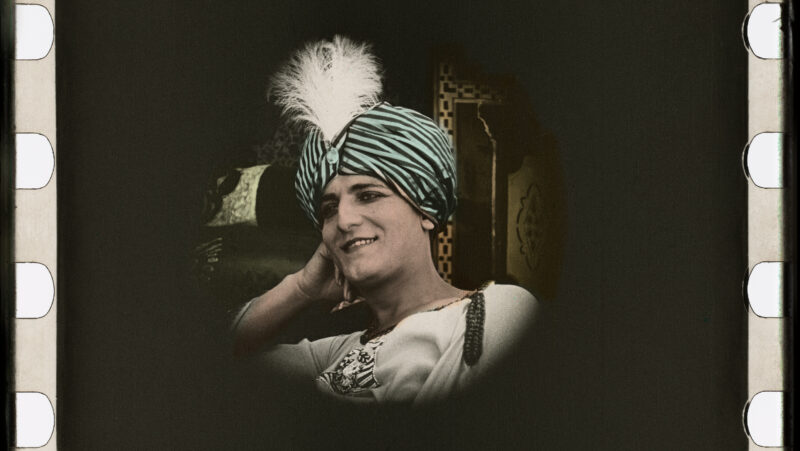THE MAJESTY OF THE ORIENT CAPTURED IN THE MESMERISING COLOURS OF LA SULTANE DE L’AMOUR: A SPECIAL EVENT WITH AN EXCEPTIONAL MUSICAL TRIO
EXPLORING THE STREETS AND SQUARES OF TRIESTE IN 1921 WITH A WORLD DEBUT OF IMAGES RESTORED BY THE CINETECA DEL FRIULI
ANNA MAY WONG LEAVES HOLLYWOOD TO BECOME A STAR IN EUROPE WITH SONG, HER FIRST GERMAN MOVIE
The Giornate del Cinema Muto / Pordenone Silent Film Festival shifts from the realism of Uzbek films to idealised images of the orient in La Sultane de l’amour (FR, 1919) by Charles Burguet and René Le Somptier, scheduled for Wednesday, 9 October 2024, 9.00 p.m., at Teatro Verdi. The latter film is based on a previously unpublished tale by orientalist Franz Touissant, who had loosely translated a section of the Persian poem Golestan in 1912, coining the expression “The Sultana of Love”. The screenplay writer and producer Louis Nalpas, founder of Compagnie des Films Louis Nalpas, chose to shoot the work in the uplands around Nice, because he felt the light and landscapes of the South of France suited the film perfectly. The work’s spectacular nature and taste for adventure and exoticism in its telling of the love story between Princess Daoulah (the “Sultana of Love”) and Prince Mourad led it to great success when the black-and-white version was released in 1919. In fact, the same company went on to release a new version in 1923, coloured using the “au pochoir” hand technique by 50 artists who worked for four years on the 100,000 images of the film. The magnificent restoration work by the CNC means audiences can fully enjoy the colour version that prompted such wonder at the time, and will inevitably mesmerise today’s viewers too. As per tradition, the mid-week event also features a special musical accompaniment, with an exceptional trio: Mauro Colombis on piano, Frank Bockius on percussion and Elizabeth-Jane Baldry on the harp.
Today is also the day of the Jonathan Dennis Memorial Lecture, organised by the Pordenone Silent Film Festival every year to remember this great archivist, champion of cinema culture and exceptional person. Tribute will be paid to him this year by Oscar-winning visual-effects artist Craig Barron, who appears at 6.00 p.m. at Teatro Verdi to introduce the audience to the magic of special effects in silent film in the works of Méliès, Chaplin and Murnau, before exploring the groundbreaking work of Ned Mann in The Winning of Barbara Worth, the Western being screened on 12 October 2024, closing this edition of the festival.
For the programme dedicated to Anna May Wong, the festival will present Richard Eichberg’s Song (DE/GB, 1929). This was Anna May Wong’s first lead performance in Germany, after leaving behind a Hollywood that relegated her to supporting roles. With a screenplay written especially for her by Karl Vollmöller (who soon followed this with the script for The Blue Angel), overseen by the most “Hollywood-esque” of the German directors, Richard Eichberg, Anna May Wong hit the right note with Song, spreading her stardom to Europe. She featured in the writings of philosopher Walter Benjamin, she was immortalised by expressionists Willy Jaeckel and Max Pechstein, and she was photographed by Alfred Eisenstaedt in the company of Marlene Dietrich and Leni Riefenstahl. Riding this wave of success, Wong signed an 18-month contract with British International Pictures for four films and also appeared on the stage in London and Vienna in the period.
For the Restorations & Rediscoveries series, the festival presents the 1922 German film Vanina by Arthur von Gerlach, based on Stendhal and featuring Paul Wegener and Asta Nielsen, appearing together for the first time. Another version of the same tale was released in 1961, featuring Sandra Milo and Laurent Terzieff and directed by Roberto Rossellini.
The Cineteca del Friuli will then present a restored version of The Perl of the Ruins (IT, 1921) in collaboration with the Vitrotti Archive. Though the story is conventional, the setting is the real focus here, exploring outdoor scenes, streets, squares and workplaces of Trieste. This little film, lasting just 26 minutes, was probably produced or commissioned by Lloyd Triestino as a form of self-promotion, showing the majesty of its headquarters and, above all, the excellence of its work.
Wednesday will draw to a close with three films from Latin America, including En el inferno del chaco (Paraguay, 1932), one of only two films that survived what is considered the bloodiest war in twentieth-century South-American history between Paraguay and Bolivia.
The online programme for Wednesday, 9 October 2024, starting at 2.00 p.m., is dedicated to Ben Carré, with piano accompaniment by José María Serralde Ruiz, featuring Roméo Bosetti’s La course aux Potirons (FR, 1908), Étienne Arnaud’s La mort de Mozart (The Death of Mozart, FR, 1909) and Maurice Tourneur’s Trilby (US, 1920).
The Pordenone Silent Film Festival / Le Giornate del Cinema Muto is made possible thanks to the support of the Regione Autonoma Friuli Venezia Giulia, the Ministry of Culture — Direzione Generale Cinema, the city of Pordenone, the Pordenone-Udine Chamber of Commerce and the Fondazione Friuli.


 Italiano
Italiano
Recent Comments